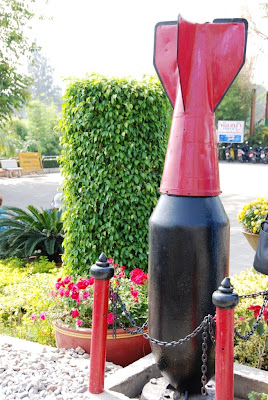2/5/2007 ~ Bangkok: Kanchanaburi
The remainder of the afternoon was quite somber. I went to the province of Kanchanaburi, home to the new Thailand-Burma War Museum, the War Grave Cemetery and the River Kwai and its infamous bridge.

Construction of the Thailand-Burma Railway began on September 16, 1942 at two existing railroad terminals, one in Thanbyuzayat in Burma and the other in Nong Pladuk, Thailand, about 25 miles west of Bangkok, in the Ratchburi province.
As early as 1939, the Japanese had drawn up plans to build the railway, which was to provide a supply line capable of transporting 3,000 tons of supplies per day to support their frontline troops in Burma. At that time, Japanese engineers estimated that the 257-mile line would take five years to build because of the harsh conditions and treacherous terrain, requiring high bridges and deep mountain cuttings.
But the railway was completed in just 16 months when the two separate lines joined 23 miles south of the Three Pagoda's Pass. But the cost was incredibly high.
Though records are sketchy, approximately 61,000 Allied prisoners of war are believed to have labored on the railway, including 30,000 British (6904 deaths), 18,000 Dutch (2782 deaths), 13,000 Australian (2802 deaths). Another 200,000 Asian laborers, mostly Thai, Malay and Burmese, were forced to work on the railway, of which more than 80,000 lost their lives. Many died from diseases like cholera, beri beri, malaria, and typhoid.
Across the street is the Don-Wak War Cemetery.
 It contains the remains of 6982 Australian, Dutch and British prisoners who lost their lives during the construction of the railway.
It contains the remains of 6982 Australian, Dutch and British prisoners who lost their lives during the construction of the railway. 
This is the Dutch section of the cemetery.

 Seven hundred American prisoner of war soldiers also worked on the railway, resulting in 131 deaths. All the remains were retrieved and buried at Arlington Cemetery. (I don't believe I've seen that section even with all the trips I've made to their; something to check out next time.)
Seven hundred American prisoner of war soldiers also worked on the railway, resulting in 131 deaths. All the remains were retrieved and buried at Arlington Cemetery. (I don't believe I've seen that section even with all the trips I've made to their; something to check out next time.) The railway operated for just 21 months before it was crippled by Allied weapons, including the revolutionary radio-controlled AZON bomb.
The railway operated for just 21 months before it was crippled by Allied weapons, including the revolutionary radio-controlled AZON bomb.  Most of the railway was dismantled soon after the wars end with the rest lost to the Thai and Burmese jungles.
Most of the railway was dismantled soon after the wars end with the rest lost to the Thai and Burmese jungles.The curved spans are part of the original bridge, the square ones are the repaired areas.
This is the view from the other side of the river.



<< Home